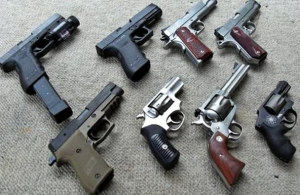
What Happens When Fear Drives Firearm Storage?
“It’s for protection.”
That’s the answer many Americans give when asked why they own a firearm. And yet, a major new study suggests that this very reason—fear of harm—may be working against basic safety practices, increasing the risk of tragedy instead of preventing it.
A nationally representative survey of 10,000 U.S. adults, conducted in January 2024, offers the most detailed look yet at how and why Americans store their firearms the way they do. While nearly half of gun owners report storing their guns “locked and unloaded,” two-thirds say they can still access a firearm in under a minute. The tension between feeling safe and being safe is at the heart of this issue—and public health experts are paying close attention.
Why Storage Matters—And Who Gets Hurt
Firearms in the home are linked to an increased risk of suicide, accidental shootings, and domestic violence. Children and teens are especially vulnerable. Research shows that locking up guns can save lives—particularly when ammunition is stored separately.
In fact, states with the strictest “Child Access Prevention” (CAP) laws—those that require guns to be locked anytime they’re not in the owner’s direct control—saw significantly more secure storage. But here’s the twist: the majority of gun owners don’t live in those states, and many are driven by something CAP laws can’t always address—fear.
A Nation Divided: Who Stores Guns Securely?
The study’s authors dug deep into the demographics and found some clear trends:
- Women were more likely than men to lock up their guns.
- Parents of children under 18 were more likely to store firearms safely.
- Those who own fewer guns (one or two) were also more likely to use locks and safes.
- People who own guns for hunting, sport, or collecting had much higher rates of secure storage than those who own for protection.
But one of the most telling findings? People who were more afraid of being shot—whether at home, at work, or walking their neighborhood—were less likely to store their firearms securely.
It’s a paradox: the people who feel most at risk are doing the least to protect their households from unintentional harm.
Measuring More Than Locks and Safes
One innovative feature of this study was its use of an indirect measure of secure storage. Instead of only asking about locks, researchers also asked how long it would take respondents to access a firearm in the middle of the night.
If it’s under 60 seconds, chances are that gun isn’t locked and unloaded. This second question helped uncover a broader picture of gun safety—one shaped more by urgency and perceived threat than by ownership laws alone.
And it turns out, speed matters. Respondents with histories of gang involvement, victimization, or incarceration were significantly more likely to have immediate access to a firearm—despite being in higher-risk environments for gun violence.
What Drives Storage Decisions?
Owning a gun for protection seems to shift the way people think about storage. This mindset isn’t always rooted in actual threat. Instead, it’s often shaped by broader cultural, psychological, and political narratives—like a belief that society is unraveling or that law enforcement can’t be relied upon.
In fact, the study found that Republican gun owners were significantly more likely to keep firearms accessible and unlocked compared to Democrats. Interestingly, these same owners reported lower levels of neighborhood fear than non-gun owners, suggesting that fear might not be about immediate danger—but rather, about generalized unease.
This opens up a vital opportunity: public health efforts can’t just say “lock your guns.” They have to address the “why” behind the behavior.
Lessons for Public Health
If we want to reduce gun injuries and deaths, we need to change how we talk about gun safety.
- Tailor the message. Someone who owns guns for hunting is more likely to respond to safety logic than someone who owns for protection. Public health campaigns must account for these differences.
- Choose the right messengers. Law enforcement or politicians might not be trusted by communities with histories of trauma or criminal-legal system involvement. Peer advocates, community leaders, and even gun store owners might be more effective.
- Start at the point of purchase. Many new gun owners are open to information—especially if it feels supportive, not judgmental. Brief, practical conversations about access time, storage options, and child safety could make a long-term impact.
What Comes Next?
This study highlights the need for smarter, more compassionate approaches to firearm safety. It also points to some key research gaps:
- How do people define a “threat,” and how does that change their storage choices?
- Can indirect measures like access time predict actual harm better than self-reports of locking behavior?
- What strategies actually reduce fear and increase willingness to secure firearms?
With firearm ownership on the rise—and with political debates making it harder to have honest conversations—this research offers a path forward: one that’s data-driven, person-centered, and rooted in public health principles.
Join the Conversation
🧠 How does your community talk about firearm safety?
🔐 Do you think access speed is a useful way to measure secure storage?
📣 What kinds of messengers would be most effective where you live?
Let us know in the comments—or share this blog to keep the conversation going.
You’re Missing the Headlines That Matter
🚨 Critical science is unfolding—are you in the loop?
Each week, This Week in Public Health delivers need-to-know insights that shape policy, practice, and community health. If you’re not reading it, you’re already behind.👉 Subscribe for free now to stay ahead.
📢 Share this blog—someone you know needs to see it too.



